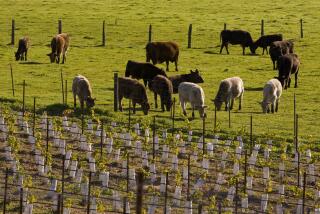Cracking the United Egg Producers
Consider the egg, so dense in nutrients, inexpensive to produce and conveniently packaged that nutritionists sometimes call it the perfect food. And yet, the perfect egg is produced in such decidedly imperfect ways that it’s at the heart of a wrenching food fight among animal rights activists, farmers and retailers. The system is rotten, and changes are overdue.
Californians became more familiar than they might have wished with the ugly details of egg production in 2008, when voters were asked to approve an initiative, Proposition 2, demanding more humane treatment of hens. The initiative passed, thanks in part to a campaign led by the Humane Society of the United States noting that most chickens spend their lives packed so densely into cages that they aren’t able to move their wings. During the campaign, the Humane Society also discovered something else: The nation’s biggest trade group of egg producers was allegedly conspiring to fix prices by restricting supply.
A bevy of lawsuits followed against the United Egg Producers, whose members account for 95% of the nation’s laying hens. The actions were joined this week by food service giant Sodexo Inc. Documents intercepted by the Humane Society, combined with testimony from a big egg farm that opted to settle the case against it by providing evidence against the UEP, indicate that the trade group began urging members to cull their flocks starting in 1999, subsequently creating “animal husbandry guidelines” ostensibly aimed at giving hens more space to live in — but really intended to reduce their numbers and thus boost the price of eggs. It may have worked. Wholesale egg prices jumped by as much as 40% in 2008.
The problem for the plaintiffs in these suits is that the UEP’s actions may not be illegal. The organization claims to be an agricultural cooperative formed under the 1922 Capper-Volstead Act, which allowed farmers to combine for the purpose of processing, distributing and marketing their products. Courts haven’t definitively ruled on whether such cooperatives can impose production limits that boost prices, an act that in other industries would be considered an antitrust violation.
The plaintiffs don’t necessarily have to resolve this question to win their cases; they also allege that the UEP isn’t really a Capper-Volstead cooperative because, among other things, not all of its members are egg producers. But we hope that courts deciding these and other suits against cooperatives will address the serious abuses being perpetrated against consumers by agribusiness, giving badly needed guidance to the Justice Department. When Congress passed Capper-Volstead in 1922, its clear intention was to cut out speculators and middlemen from food distribution, boosting profits for farmers and lowering prices for consumers. It’s perverse to suggest that Congress meant to allow farmers to jack up food prices by engaging in anticompetitive behavior.


